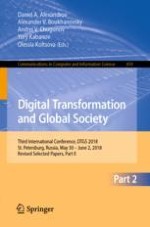This two volume set (CCIS 858 and CCIS 859) constitutes the refereed proceedings of the Third International Conference on Digital Transformation and Global Society, DTGS 2018, held in St. Petersburg, Russia, in May/June 2018.
The 75 revised full papers and the one short paper presented in the two volumes were carefully reviewed and selected from 222 submissions. The papers are organized in topical sections on e-polity: smart governance and e-participation, politics and activism in the cyberspace, law and regulation; e-city: smart cities and urban planning; e-economy: IT and new markets; e-society: social informatics, digital divides; e-communication: discussions and perceptions on the social media; e-humanities: arts and culture; International Workshop on Internet Psychology; International Workshop on Computational Linguistics.
